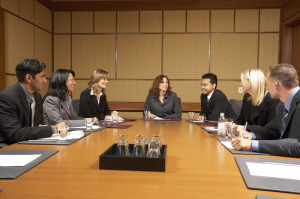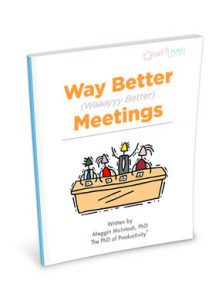Creating Meeting Magic by Chris Sier

“Coming together is a beginning. Keeping together is progress. Working together is success.” – Henry Ford
Long-winded Meetings are an Ineffective Use of Valuable Time
Perhaps you have had the same experience as I have when a two-hour meeting I planned for turned into three hours or longer. I remember a particular time when we were 45 minutes into the meeting and only on Slide 3 of a 24 slide presentation; several people were talking at once trying to prove their individual point. Since it was a teleconference, no one saw me getting fidgety. All I heard was “noise” so I stopped listening, removed my headset and took a short break. When I put my headset back on, I figured we would be at least on Slide 5. Nope, still on slide 3. Luckily, my mute button was on or everyone would have heard a major groan!
Our time is a valuable, limited resource, and we need to use it wisely. Below are ten tips to create meeting magic–staying focused and on point, with an engaged and motivated team.
Ten Effective Tips to Create Meeting Magic
-
Establish rules of meeting etiquette which participants agree to follow. Whether by phone or face to face, norms are essential to keep meetings on track (only one person speaks at a time, meeting times are honored, etc.). In the heat of the moment, people might forget the rules but when reminded by the facilitator, feelings aren’t hurt and the meeting can move forward.
-
Especially if participants are located in diverse places, allot time for getting to know each other. This allows them to feel more like a team, which will lead to working together more effectively. One way is for everyone to share a picture, a brief description of their role, and an interesting fact about themselves. (I have a beagle named Raisin who lives in our closet. I used to have two aquatic frogs named Eleanor and Franklin who lived in our bathroom, are examples).
-
Publish an agenda at least two days before the meeting with clearly stated objectives, keeping in mind:
- What information do you want others to leave the meeting with?
- What do you want to ensure is covered?
- How much time will you allot to the meeting?
-
What do you want from participants?
- What support do you need?
- What agreements do you want?
- Do you need additional resources?
-
Make sure all materials needed by the participants are included with the agenda. If they need time to review, give them adequate time to prepare.
-
A consistent agenda with time frames for each item creates a productive and on-track environment to quickly reach decisions. An example would be: objective(s), action item review (30 minutes), discussion item (30 minutes), round table (15 minutes).
- Rather than a transcript detailing the meeting discussion, only document decisions, actions, and points for further discussion. People will not read a transcript but are more likely to review bullet points.
-
Document actions in a simple table–succinctly describe the action, who is responsible, timeframe for completion, and updates. Each succeeding meeting, you can add comments in the update box, everything contained in one place.
-
If the allotted time for an agenda item is not enough, ask for agreement to continue working with this item and bumping another item to the next meeting, or having a separate meeting, or table the item for discussion at the next meeting.
-
Honor time commitments. Running over can impact everyone’s day. Staying on time keeps everyone focused and energized.
Action Steps
- Be clear and specific on what you want to cover in a meeting
- Make sure everyone has all the materials they need to successfully participate in the meeting
- Have norms and stick to them
© Chris Sier, PCC, CUCG | Executive/Leadership Coach
Expand your thinking – find your greatness
http://www.ExecutivePotentialPlus.com | Chris@ExecutivePotentialPlus.com
 If you attend &/or plan meetings (and I know you do), then you need the Get a Plan! Guide® to Waayy Better Meetings. As a society, we cannot afford to be losing productivity to meetings that are poorly designed, unnecessary, or to whom the wrong people have been invited.
If you attend &/or plan meetings (and I know you do), then you need the Get a Plan! Guide® to Waayy Better Meetings. As a society, we cannot afford to be losing productivity to meetings that are poorly designed, unnecessary, or to whom the wrong people have been invited.



